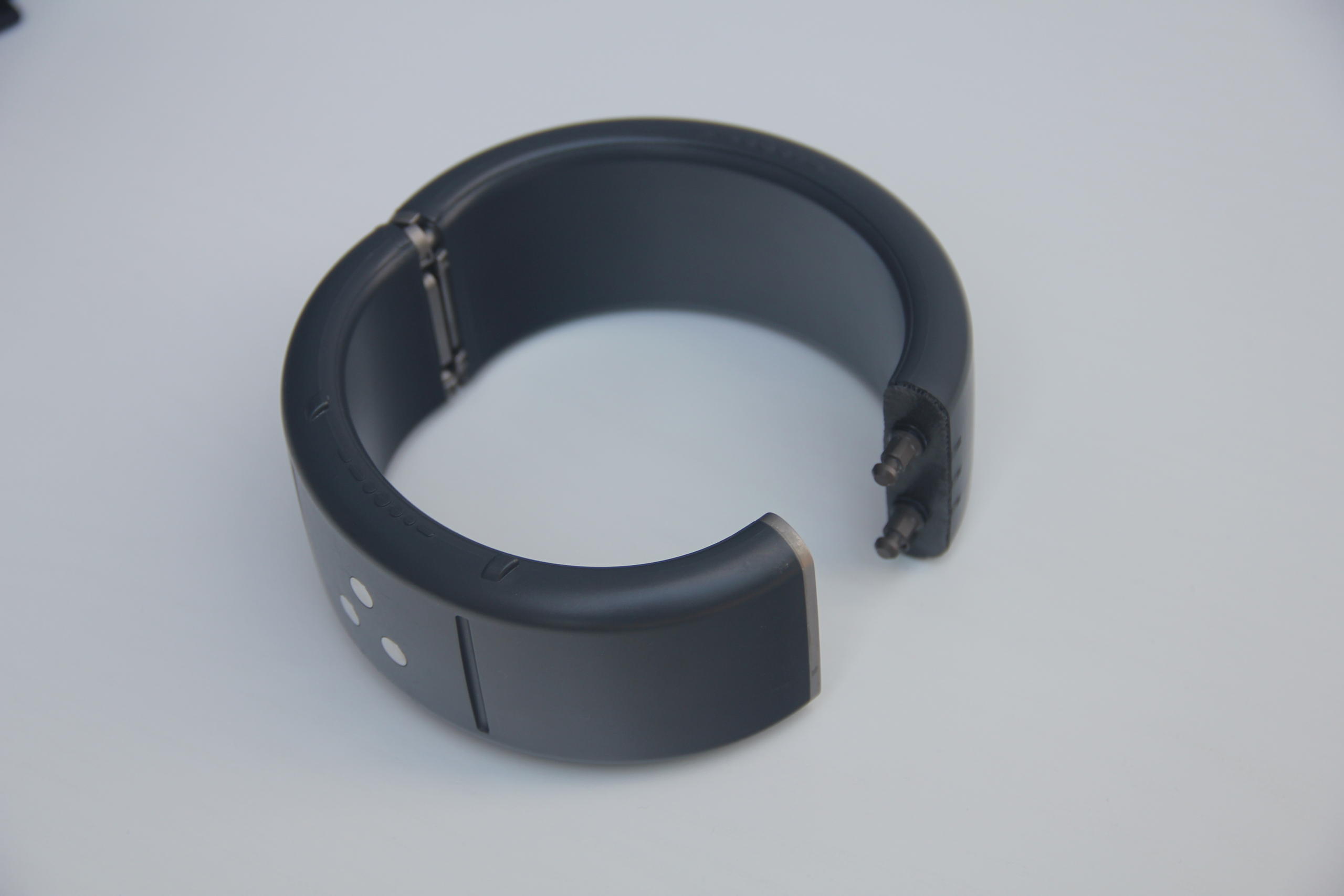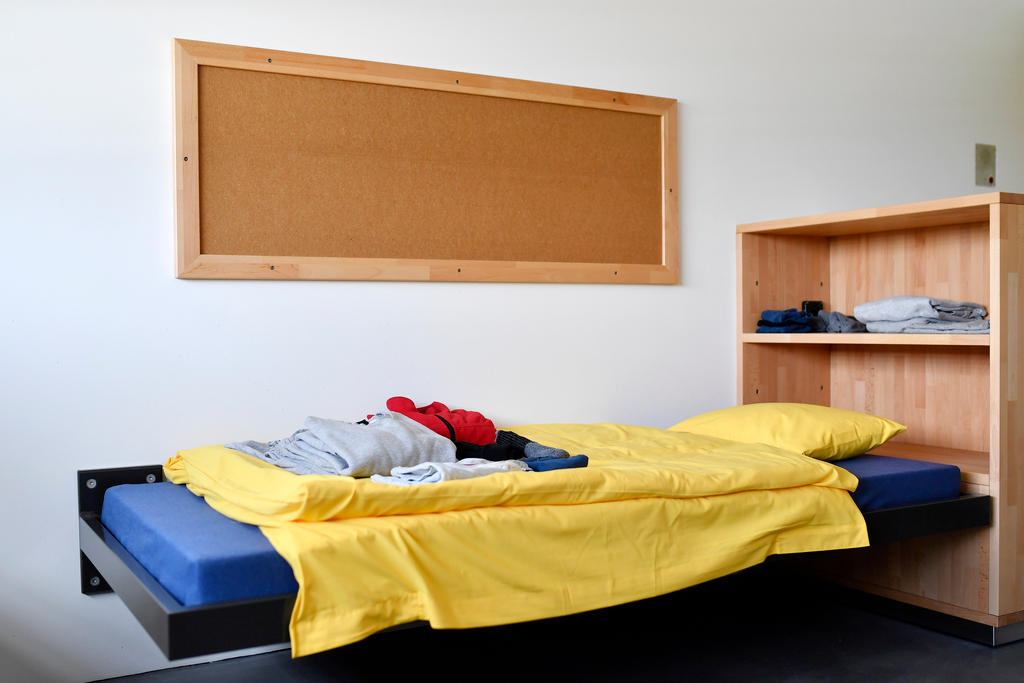
Swiss-made ankle bracelets ride global prison reform trend

Electronic monitoring of convicted offenders is now being used in many countries for short sentences. Swiss company Geosatis has become one of the principal suppliers of electronic ankle bracelets worldwide.
“Today it is being more and more realised that imprisonment may not be the best solution for small offenders. In jail they may be subject to negative influences from prisoners who have committed more serious crimes. They are also completely cut off from the world: when they are released they often feel lost, they no longer have work or sometimes even a home,” says François Vigier, communication manager for Geosatis.
According to him, electronic monitoring helps low-risk criminals reduce the risk of reoffending compared to being stuck in jail. Several countries have reached the same conclusion. First introduced in the US in the 1980s, electronic monitoring is today being used or experimented with in about forty countries, including Switzerland. Around the world there are about 350,000 people wearing “electronic bracelets” – they are in fact worn around the ankle – about half of them in North America.
Overcrowded jails
Besides keeping convicted offenders in their own social network, electronic monitoring is being regarded as a solution to overcrowding in prisons, which is a problem for over half the countries in the world. Prison occupancy is more than 400% of regular capacity in the Philippines and Haiti, 300% in Bolivia, Guatemala, Uganda and Zambia, and 200% in twenty other countries.
To a lesser extent, European nations also face prison overcrowding.
In Switzerland, with an occupancy rate of 94%, the situation looks manageable in comparison. Yet given that the serving of jail terms is a matter for the cantons, there are considerable differences from one institution to another. In some places occupancy is over 150%.
José Demetrio was struck by this problem ten years ago. In the course of his work he had to visit a jail in Geneva which was always overcrowded, and the specialist in security applications saw that many of the prisoners did not really need to serve their sentences behind bars. The kinds of electronic bracelets available then had technical problems, however.
In particular, they could be manipulated easily and they used radio frequency technology, which just verified the monitored person’s presence in a particular place – usually, at home or in the workplace. In 2011 Demetrio founded the start-up Geosatis, with the aim to develop a monitoring system that was more secure and effective in partnership with the Lausanne Federal Institute of Technology (EPFL).
Sophisticated product
The result is a technologically sophisticated bracelet, fitted with two SIM cards and capable of transmitting the location of the wearer through a GPS (Global Positioning System) receiver via satellite, as well as a radio frequency link. “With the satellite technology we can follow every movement of the person between home and work. We know what speed he is moving at, if he is taking a different route from the usual one, or if he is leaving a determined area,” explains Vigier.
Made of plastic and titanium, the anklet is manipulation-proof, he emphasises. “If any attempt is made to pull, cut or forcibly remove the bracelet, internal sensors send an alarm signal to the software, which relays it to the police station or the monitoring centre.” There is also an alarm when the charge on the battery falls below a certain level.
This high-tech system is not just due to the advanced knowledge of Swiss engineers, but also to the Swiss watchmaking tradition. Demetrio has his company offices in Le Noirmont, canton Jura, in order to benefit from the wide experience of the watchmaking industry in the field of precision mechanics and microtechnology. This seems to have been a good choice, since Geosatis has managed in a few short years to establish itself on the internationally, even on the American market, where the main competition is.

More
Switzerland’s leniency on criminals, explained
Slow to catch on in Switzerland
Already used in twenty countries across five continents, the Geosatis bracelet has not yet conquered Switzerland, where electronic monitoring has been slow to make headway. In 1999 the federal government authorised some cantons to try out this method for convicted persons serving short sentences. Despite positive findings on the initial tests, the government and parliament decided in the early 2000s to go with an amendment to the Criminal Code that would allow short sentences to be converted to fines or community service.
This reform became law in 2007, but its limits soon became obvious: too many people sentenced in this way managed to get out of discharging their obligations. In 2015 parliament changed its mind with a new amendment to the criminal law effective since 2018, which recognised electronic monitoring as an alternative to jail sentences up to one year, or for the final phase of a long sentence.
This option can be allowed at the convicted person’s request, if particular criteria are met. In particular, if the convict is not likely to abscond or re-offend, if he has a place to live and a job or training opportunity, and if those who live with him are in agreement. According to the law now, the punitive element is still present in electronic monitoring in that it significantly limits the freedom of movement and free time of the convicted offender, since he is required by the sentencing plan to be in certain places at certain times.
Cantons undecided
Electronic monitoring is the lowest-cost way for offenders to serve their sentences, and costs even less than community service. The costs could be kept down, too, if all cantons chose the same bracelet and one operating centre was set up to cover the whole country, able to provide monitoring 24 hours a day. So far the cantons have not come to an agreement. Some want to use the Geosatis system, others want to go with an American company based in Israel. Still others hesitate to come on board.
Accordingly, electronic monitoring is still in the pilot phase and is being used for a couple of hundred offenders a year – there were about 400 in 2018. Lacking a consensus, the cantons have decided to put the project out to public tender, hoping to have a nationwide solution in place by 2023.
While the electronic bracelet makes slow progress in Switzerland, at international level it continues to be adopted. Since starting up, Geosatis has just about doubled its turnover and staff every 1-2 years, creating over 80 jobs. “At the outset we used to have orders for under a hundred bracelets a year, then for about a hundred, and now we are at several thousand,” Vigier was pleased to tell swissinfo.ch.
At the end of 2018, the Swiss parliament adopted amendments to civil and criminal law to provide better protection to victims of domestic violence and stalking. The new legal framework, due to come into force in 2022, provides for orders for electronic monitoring using a geolocation bracelet for those convicted of such offences. With satellite-based geolocation systems, it is possible to define an exclusion zone, typically where the victim lives and where the offender may not go.
Adapted from Italian by Terence MacNamee

In compliance with the JTI standards
More: SWI swissinfo.ch certified by the Journalism Trust Initiative




























You can find an overview of ongoing debates with our journalists here . Please join us!
If you want to start a conversation about a topic raised in this article or want to report factual errors, email us at english@swissinfo.ch.